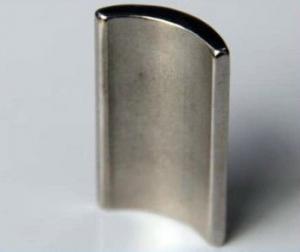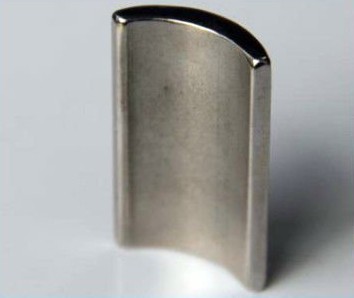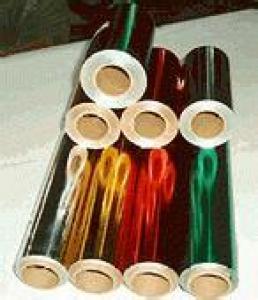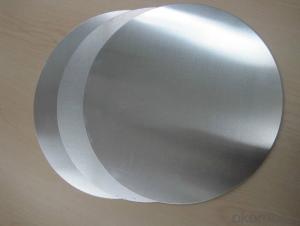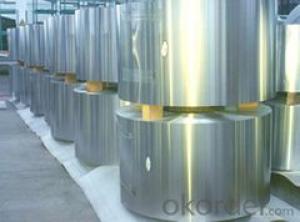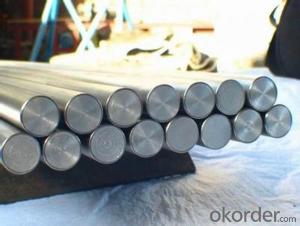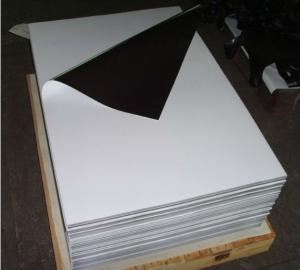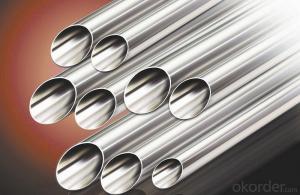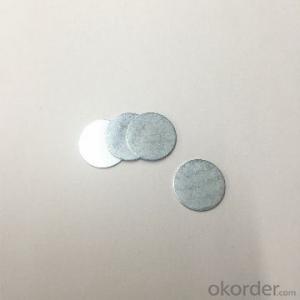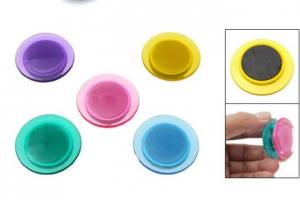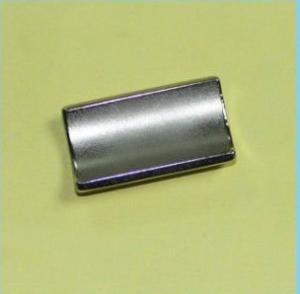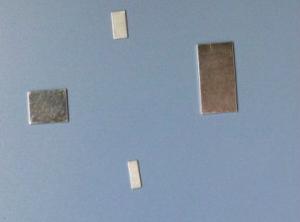Generator NDFEB Magnet Segment
- Loading Port:
- China Main Port
- Payment Terms:
- TT or LC
- Min Order Qty:
- 1 Piece pc
- Supply Capability:
- 100 Tons per Month pc/month
OKorder Service Pledge
OKorder Financial Service
You Might Also Like
Detailed Product Description
Generator Magnet Segment:Grade in M,H,SH,EH series
Coating:Ni,Cu,Ni,Zn, Sn, Ag,
Work Temperature:as high as 200 Centigrade!
The sintered NdFeB magnet is a high properties permanent magnetic material, which is formed by metals Neodymium, iron, boron and some other rare earth elements.
Because of its best properties, reasonable price, the sintered NdFeB magnet are developed rapidly and found in wide applications such as communication, traffic, instrument, electro-acoustics, motors, magnetic therapy, magnetic machinery, magnetic separation, magnetization technology, etc.
Now our company produces high properties magnetic materials in various grades, such as N35-53, 35-50M, 30-48H, 30-42SH, 28-40UH-, 28-35EH with Br 11~14.9 Kgs and iHC 12~30 Koe.
Per your requirement, the sintered NdFeB magnet can be customized into many shapes, such as triangle/square/rectangle/block, trapezium, round/circle/ring/ball(sphere)/sphere/rod/stick/pot, bar, strip, tile/arc, cube, cylinder, cone, disc/disk, segment, etc or some irregular shapes. Our company can also optimize NdFeB magnet with consideration of its work environment(temperature, force, etc).
The NdFeB magnet surface can be treated and coated in many requested ways, such as coated with Zn,Ni,Sn,Ag,Au,epoxy resin or with Pb element eliminated etc.
- Q: what do you mean by radial magnetic field???why,in case of paramagnetism,dipoles get temporarily aligned whereas permanently in ferromagnetism???
- Radial magnetic field usually means a magnetic field in a direction that is away (or towards) your center of axis. A ferromagnetic compound will divide itself to domain each of which has a total magnetic moment in some random direction. An external field increases the size of domains pointing to that direction, and thus you get 'permanent alignment'. A paramagnetic material does not have domains - each moment of the atoms points in a random direction, and the external field will only have a linear response as long as it is there. When it's turned off, all domains go back to pointing randomly.
- Q: Why do magnets suck up each other?
- Most substances are made up of molecules. Molecules are made up of atoms. Atoms are made up of nuclei and electrons. Inside an atom, electrons rotate constantly and rotate around the nucleus. These two movements of electrons produce magnetism. In most materials, however, the motion of electrons varies in different directions, and the magnetic effects cancel out. As a result, most substances do not exhibit magnetism under normal conditions and have no magnetic force outside.
- Q: Superconductors work as, when cooled to a certain point, they lose all electrical resistance. This near absolute zero temperature causes atoms to cease random vibrations, thereby allowing un-impeded flow for its electrons and a total loss of electrical resistance. The Meissner effect is a common property of these zero electrical resistant superconductors. It works because the magnet’s magnetic field cannot penetrate the superconductor, causing its lines of force to be expelled back at it. This has the effect of creating a mirror-image of the magnet within the superconductor and, through the expelled lines of force it is creating, causes itself to levitate.QUESTION : Why does the superconductor repel magnetic fields?
- The exclusion of magnetic flux is brought about by electrical screening currents that flow at the surface of the superconducting material and which generate a magnetic field that exactly cancels the externally applied field inside the superconductor. Superdiamagnetism established that the superconductivity of a material was a stage of phase transition. Superconducting magnetic levitation is due to superdiamagnetism, which repels a permanent magnet, and flux pinning, which prevents the magnet floating away.
- Q: Iron ore beneficiation, flotation or magnetic separation?
- blades are better than refills and its not an extra ten minutes/P I A
- Q: difference between diamagnetic, paramagnetic, and ferromagnetic materials?
- HAHAHAHAHA i dont know why, but reading that made me laugh my *** off
- Q: What do you mean by N, H, SH and so on in the specifications of magnetic materials?
- The coercivity is Gs (Gauss). Magnetic materials such as in the closed state by external magnetic field magnetization to saturation, and then withdraw the external magnetic field, permanent magnet magnetic polarization J and internal magnetic induction B and will not disappear because of the disappearance of the H and the external magnetic field, and will maintain a certain size value, the value is the remanence of the material remaining magnetic polarization Jr and residual magnetic induction Br. The unit is T (Tesla) in the SI system and is Gs (Gauss) in the CGS system.
- Q: A. Liquid iron B. Metallic hydrogen C. Molecular hydrogen D. Water-ammonia slush I think A and D may be responsible, but i‘m not sure whether B and C are.
- The transmission fluid is either low or the fluid level is low.
- Q: What is magnetic coercivity;give examples of it in at least 1 one experiment?
- In materials science, the coercivity, also called the coercive field, of a ferromagnetic material is the intensity of the applied magnetic field required to reduce the magnetization of that material to zero after the magnetization of the sample has been driven to saturation. Coercivity is usually measured in oersted or ampere/meter units and is denoted HC. Coercivity measures the resistance of a ferromagnetic material to becoming demagnetized. Coercivity can be measured using a B-H Analyzer. Materials with high coercivity are called hard ferromagnetic materials, and are used to make permanent magnets. Permanent magnets find application in electric motors, magnetic recording media (e.g. hard drives, floppy disks, or magnetic tape) and magnetic separation. A material with a low coercivity is said to be soft and may be used in microwave devices, magnetic shielding, transformers, or recording heads. As for an experiment, it is used in magnetic information storage. The main challenge in designing magnetic information storage media is to retain the magnetization of the medium despite thermal fluctuations caused by the superparamagnetic limit. If the thermal energy is too high, there may be enough energy to reverse the magnetization in a region of the medium, destroying the data stored there. The energy required to reverse the magnetization of a magnetic region is proportional to the size of the magnetic region and the magnetic coercivity of the material. The larger the magnetic region is and the higher the magnetic coercivity of the material, the more stable the medium is. There is a minimum size for a magnetic region at a given temperature and coercivity. If it is any smaller it is likely to be spontaneously de-magnetized by local thermal fluctuations. Perpendicular recording uses higher coercivity material because the head's write field penetrates the medium more efficiently in the perpendicular geometry. Hope this helps!
- Q: so i wanna make a linear accelerator for a project im a first year engineering student and i have some capacitors, and i have the tube n coil made now i have a button switch and i can use 1 capacitor to accelerator a projectile, but i want to use multiple capacitors to accelerator the projectile so what i wanna do is have those coils at different parts in the tube and i want each capacitor to discharge when the projectile gets to it in the tube so that capacitor activates its magnetic fieldso how cud i create a circuit that timely discharges creating the magnetic field n accelerating the projectile?
- Interesting, but whatever you are accelerating needs to be detected so that you dump the power when it is halfway past the coil for each coil in the chain. See the links below for more information. The first is a 1.25kJ coilgun video. The second has theory and design considerations with references and bibliography, and the third is a free program to design coilguns with multiple coils and components. You should understand that your accelerator will do fine with magnetic materials, like iron projectiles but will do little or nothing for charged particles. For that you need a different form of accelerator with static charges that keep moving ahead of the particles and changing behind them. (To accelerate a proton, negative ahead and positive behind, for example). To understand the movement of charged particles versus magnetic fields, you need to be capable of calculating curl, which requires some vector mechanics and partial differential equations--a bit more than first year students are taught. Finally, any such circuit has resistance (R), inductance (L), and capacitance, (C). With those three components alone you have an RCL circuit which is roughly described by the second-order ordinary differential equation: d^2I/dt^2+(R/L)dI/dt+(1/L)I0 Which is good for a steady source voltage only. The magnetic flux is proportional to dI/dt
- Q: What are the differences between BHC and IHC in magnetic materials?
- The general coercivity is the coercive force of zero magnetic induction, and the intrinsic coercivity is the coercive force with zero magnetic polarization.
1. Manufacturer Overview
| Location | Guangdong,China (Mainland) |
| Year Established | 2010 |
| Annual Output Value | US$2.5 Million - US$5 Million |
| Main Markets | North America South America Eastern Europe Southeast Asia Africa Eastern Asia Western Europe Northern Europe Southern Europe South Asia |
| Company Certifications | ISO9001:2000 |
2. Manufacturer Certificates
| a) Certification Name | |
| Range | |
| Reference | |
| Validity Period |
3. Manufacturer Capability
| a) Trade Capacity | |
| Nearest Port | Shenzhen |
| Export Percentage | 21% - 30% |
| No.of Employees in Trade Department | 3-5 People |
| Language Spoken: | English, Chinese |
| b) Factory Information | |
| Factory Size: | 3,000-5,000 square meters |
| No. of Production Lines | 2 |
| Contract Manufacturing | OEM Service Offered |
| Product Price Range | Average |
Send your message to us
Generator NDFEB Magnet Segment
- Loading Port:
- China Main Port
- Payment Terms:
- TT or LC
- Min Order Qty:
- 1 Piece pc
- Supply Capability:
- 100 Tons per Month pc/month
OKorder Service Pledge
OKorder Financial Service
Similar products
Hot products
Hot Searches
Related keywords
